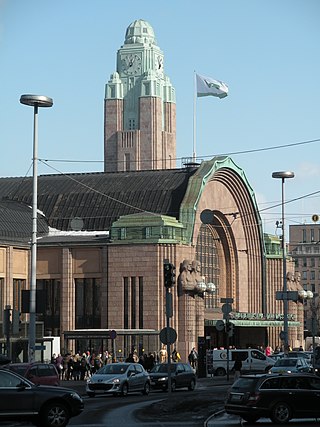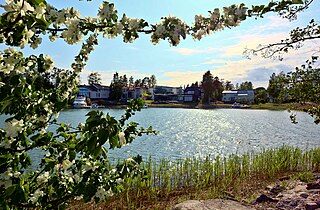
Helsinki is the capital and most populous city in Finland. It is on the shore of the Gulf of Finland and is the seat of southern Finland's Uusimaa region. About 682,000 people live in the municipality, with 1.26 million in the capital region and 1.6 million in the metropolitan area. As the most populous urban area in Finland, it is the country's most significant centre for politics, education, finance, culture, and research. Helsinki is 80 kilometres (50 mi) north of Tallinn, Estonia, 360 kilometres (220 mi) north of Riga, Latvia, 400 kilometres (250 mi) east of Stockholm, Sweden, and 300 kilometres (190 mi) west of Saint Petersburg, Russia. Helsinki has significant historical connections with these four cities.

Vantaa is a city in Finland. It is located to the north of the capital, Helsinki, in southern Uusimaa. The population of Vantaa is approximately 250,000. It is the 4th most populous municipality in Finland. Vantaa is part of the Helsinki Metropolitan Area, which has approximately 1.6 million inhabitants.

Hakaniemi is an unofficial district of Helsinki, the Finnish capital. It covers most of the neighbourhood of Siltasaari in the district of Kallio. Hakaniemi is located at the sea shore and is separated from the city centre by the Siltavuorensalmi strait and from the district of Linjat by the street Hämeentie. Historically, Hakaniemi was often associated with the working class and workers' associations. However, the cost of living has risen considerably in recent years and is now on par with that of the rest of central Helsinki.

Lauttasaari is an island in Helsinki, Finland, about 3 kilometres (1.9 mi) west of the city centre. Together with some surrounding unpopulated small islands, Lauttasaari is also a district of Helsinki. With 23,226 residents as of 2017, the island is Finland's second largest by population, after Fasta Åland. Its land area is 3.85 km2.

Kulosaari is an island and an East Helsinki suburb in Helsinki, Finland. It is also the 42nd neighbourhood of the city. Construction of villas on the island started in the beginning of the 20th century, and a bridge from Sörnäinen was opened in 1919. Kulosaari was an independent municipality since 1922 until 1946, when it was merged to Helsinki.

Helsinki Central Station (HEC) is the main station for commuter rail and long-distance trains departing from Helsinki, Finland. About 200,000 people "pass through the station" every day, half of whom are train passengers. The station serves as the terminus for all trains in the Helsinki commuter rail network, as well as for all Helsinki-bound long-distance trains in Finland. The Rautatientori metro station is located in the same building.

Pasila station is a railway station in Helsinki, Finland, approximately 3.5 kilometres (2.2 mi) north of Helsinki Central. It is the second busiest railway station in Finland, after Helsinki Central, and takes up a large part of the district of Pasila. The station was first opened in 1862 along the Finnish Main Line. The current station building opened in 2019.

Pasila is a part of Helsinki, Finland, that is both a central-northern neighbourhood and district, bordering the areas of Alppila to the south, the Central Park (Keskuspuisto) to the west, and Vallila to the east.

East Helsinki is an area in Helsinki, Finland, usually thought to comprise the city's eastern and south-eastern major districts, including the districts of Vartiokylä, Myllypuro, Mellunkylä, Vuosaari, Herttoniemi, Laajasalo and Kulosaari. With the exception of Kulosaari, the buildings in the area are relatively new – most have been built in the 1960s or later – and constitute relatively densely inhabited suburbs, except for the southern part of Laajasalo and most of Kulosaari. On the other side of the bridge to the west of Kulosaari is Helsinki Downtown, the so-called "South Helsinki". Officially, the name "East Helsinki" is not found in the city's regional nomenclature, but it was a name created by the locals of the area.
The city of Helsinki, the capital of Finland, can be divided into various sorts of subdivisions. Helsinki is divided into three major areas: Helsinki Downtown, North Helsinki and East Helsinki. The subdivisions include boroughs, districts, major districts and postal code areas. The plethora of different official ways to divide the city is a source of some confusion to the inhabitants, as different kinds of subdivisions often share similar or identical names.

Westend is a district of the city of Espoo, Finland. It is located next to Tapiola and about ten kilometers from the center of Helsinki. From Westend Helsinki can be reached along Länsiväylä. Known as an affluent area, Westend is the wealthiest postal code area of Finland by mean household income. In 2019, the area was home to more than 3,000 residents.

Koivusaari is an island and a part of the district of Lauttasaari in Helsinki, Finland. The island hosts two yacht clubs and a former Nokia training centre. The current island of Koivusaari has been formed by combining the island of Koivusaari proper with the island of Leppäsaari to the south of it and expanding it. Since the late 1990s and early 2000s there have been plans to construct a new residential area on reclaimed land in Koivusaari, served by the Koivusaari metro station.

Hakunila, is a district and major region of the municipality of Vantaa, Finland, located within the eastern part of the city. The district has a population of 11,238 and a population density of 3,746 inhabitants per square kilometre (9,700/sq mi).

Munkkiniemi is a neighbourhood in Helsinki. Subdivisions within the district are Vanha Munkkiniemi, Kuusisaari, Lehtisaari, Munkkivuori, Niemenmäki and Talinranta.

Malmi is a regional center and a major district on the north-eastern part of Helsinki, Finland. It has a population of 24,312 (2008). The Malmi District is divided into six subareas, two of which are the center forming Ylä-Malmi and Ala-Malmi, and the rest are Tattariharju, Malminkenttä. Malmin peruspiiri is a related but distinct subdivision of Helsinki which does not include Pihlajamäki and Pihlajisto, but instead includes Tapanila and Tapaninvainio. The population of this area is approximately 27,800.

Jätkäsaari is a peninsula and a quarter in Helsinki, the capital city of Finland. It is part to the Kampinmalmi district and Länsisatama neighbourhood. It was the site of the main container port in Helsinki until late 2008, when the harbour moved to the new facilities in Vuosaari. The terminals for passenger ferries to Tallinn and Saint Petersburg remain in Jätkäsaari at the West Harbour.

Itä-Pasila (Finnish), Östra Böle (Swedish) is a neighborhood in the Pasila subdivision of Helsinki, Finland.

Korso is a district and major region in Helsinki metropolitan area, in northeastern Vantaa, Finland. The district has 7,402 inhabitants.
Märta Blomstedt (1899–1982) was an architect and one of the driving forces of the Finnish functionalism movement. Partnering with her husband, Pauli E. Blomstedt, her first works were noted for their functional, rather than decorative appearance and settings in park-like environments. After her husband's death, initially she formed a firm with Matti Lampén to complete projects her husband and she had begun. Later, she and Lampén formed a firm designing their own creations. She designed all aspects of her buildings including the furnishings, demonstrated in one of Blomstedt & Lampén's most noted designs of the Hotel Aulanko. During the war, Blomstedt & Lampén mostly worked on renovation and restoration projects of existing buildings, but at the war's end, they returned to their own designs. In addition to buildings, they were responsible for the city plans for Kuusjärvi and the Oravikoski Mining Community and created both public and private buildings in each city as well. When Lampén died, Blomstedt formed a partnership with Olli Penttilä and continued to work into the 1970s.

The Battle of Helsinki was a 1918 Finnish Civil War battle, fought on 12–13 April by the German troops and Finnish Whites against the Finnish Reds in Helsinki, Finland. Together with the battles of Tampere and Vyborg, it was one of the three major urban battles of the Finnish Civil War. The Germans invaded Helsinki despite the opposition of Finnish White Army leader Carl Gustaf Emil Mannerheim who wanted to attack the capital city with his own troops after Tampere had fallen on 6 April. However, the Germans had their own interest in taking Helsinki as quickly as possible and then moving further east towards the Russian border. The city had been under Red control for 11 weeks since the beginning of the war.



















